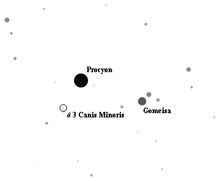Delta3 Canis Minoris
- For other star systems with this Bayer designation, see δ Canis Majoris.
| Observation data Epoch J2000.0 Equinox J2000.0 | |
|---|---|
| Constellation | Canis Minor |
| Right ascension | 07h 34m 15.89238s[1] |
| Declination | +3° 22′ 18.1956″[1] |
| Apparent magnitude (V) | +5.81[2] |
| Characteristics | |
| Evolutionary stage | Main sequence |
| Spectral type | A0Vnnp[3] |
| Astrometry | |
| Parallax (π) | 5.67 ± 0.34[1] mas |
| Distance | 580 ± 30 ly (180 ± 10 pc) |
| Other designations | |
| Database references | |
| SIMBAD | data |

Star map of the 25 brightest stars in Canis Minor. Delta3 Canis Minoris is circled.
Delta3 Canis Minoris (δ3 CMi, δ3 Canis Minoris) is a star in the constellation Canis Minor. It is approximately 680 light years from Earth.
δ3 Canis Minoris is a white A-type main sequence dwarf with an apparent magnitude of +5.81.
References
- 1 2 3 Van Leeuwen, F. (2007). "Validation of the new Hipparcos reduction". Astronomy and Astrophysics. 474 (2): 653. Bibcode:2007A&A...474..653V. doi:10.1051/0004-6361:20078357.
- ↑ Johnson, H. L.; Mitchell, R. I.; Iriarte, B.; Wisniewski, W. Z. (1966). "Ubvrijkl Photometry of the Bright Stars". Communications of the Lunar and Planetary Laboratory. 4: 99. Bibcode:1966CoLPL...4...99J.
- ↑ Abt, Helmut A.; Morrell, Nidia I. (1995). "The Relation between Rotational Velocities and Spectral Peculiarities among A-Type Stars". Astrophysical Journal Supplement v.99. 99: 135. Bibcode:1995ApJS...99..135A. doi:10.1086/192182.
This article is issued from Wikipedia - version of the 11/2/2016. The text is available under the Creative Commons Attribution/Share Alike but additional terms may apply for the media files.